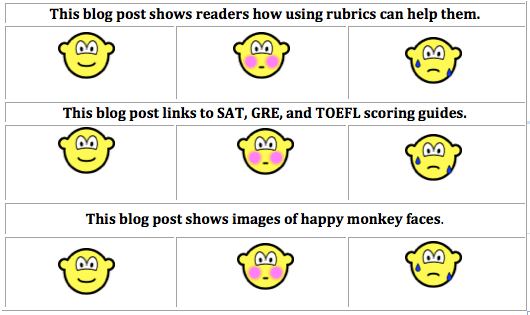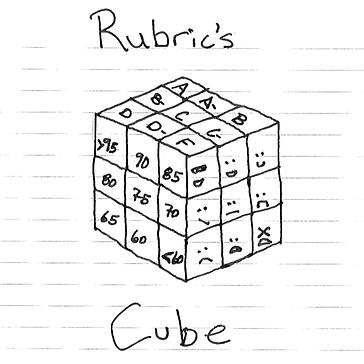It is possible that I might have one or two of these in my back pocket.....
I have a secret for you, from my years of experience as a SAT verbal tutor in Boston. Lean close, and don't let the teachers and graders know that I'm going to tell you. Here it is: you have access to a key that will grant you an A on every written assignment. It’s a rubric.
It’s easy to ignore rubrics. You’ve probably flipped past rubrics in your SAT book, and stuffed them in the back of your binders. In the post, I’ll explain how you can harness the wealth of information in a rubric to improve your writing score on the SAT, GRE, and any other assignment.
Why Should I Care about Rubrics?
A well-constructed rubric will tell you exactly how to approach an essay. It will spell out what’s most important, what details to include, and how you should style and format your writing. I’ve been an SAT verbal tutor in Boston (specifically, the MIT and Harvard neighborhood) for a long while, and I’ve seen a lot of rubrics. (In my education assessment class, I even had a "Rubric for Rubrics" to assess the rubrics I created for my own students!
Understanding a rubric is like having a window into the grader's brain. It tells you what they value in the assignment— for example, that you could earn (or lose) just as many points on the formatting as on the clarity of your phrasing. Rubrics evens the playing field, and gives you, the student, some of the power. That is useful whether it is your middle school Social Studies class, your high school AP U.S. History class, the SAT writing section, your History of Boston class at Harvard, or the GRE writing section.
How to Read a Rubric
You have to read a rubric carefully to get it right.
- First, scan the elements in the left-hand column for crucial elements. What is listed first? That’s probably the most important criterion.
- Look at each element in more detail to consider what it means to your teacher/grader. Start with the highest-scoring column (often a 4 on a scale of 1-4) and read what an "exemplary" work looks like.
- Then, look at the next column over (the 3), and try to identify what the differences are between a score of 3 and a 4. For extra clarity, look at the lowest score (the 1). How precisely can you gain or lose points?
Look at the rubric below, which I created using RubiStar. Consider this: what do you have to do to get a 3 in every category? What small changes could you make to get a 4 in each category?
|
CATEGORY |
4 |
3 |
2 |
1 |
|
Focus on Topic (Content) |
There is one clear, well-focused topic. Main idea stands out and is supported by detailed information. |
Main idea is clear but the supporting information is general. |
Main idea is somewhat clear but there is a need for more supporting information. |
The main idea is not clear. There is a seemingly random collection of information. |
|
Support for Topic (Content) |
Relevant, telling, quality details give the reader important information that goes beyond the obvious or predictable. |
Supporting details and information are relevant, but one key issue or portion of the storyline is unsupported. |
Supporting details and information are relevant, but several key issues or portions of the storyline are unsupported. |
Supporting details and information are typically unclear or not related to the topic. |
|
Introduction (Organization) |
The introduction is inviting, states the main topic and previews the structure of the paper. |
The introduction clearly states the main topic and previews the structure of the paper, but is not particularly inviting to the reader. |
The introduction states the main topic, but does not adequately preview the structure of the paper nor is it particularly inviting to the reader. |
There is no clear introduction of the main topic or structure of the paper. |
|
Sequencing (Organization) |
Details are placed in a logical order and the way they are presented effectively keeps the interest of the reader. |
Details are placed in a logical order, but the way in which they are presented/introduced sometimes makes the writing less interesting. |
Some details are not in a logical or expected order, and this distracts the reader. |
Many details are not in a logical or expected order. There is little sense that the writing is organized. |
|
Conclusion (Organization) |
The conclusion is strong and leaves the reader with a feeling that they understand what the writer is "getting at." |
The conclusion is recognizable and ties up almost all the loose ends. |
The conclusion is recognizable, but does not tie up several loose ends. |
There is no clear conclusion, the paper just ends. |
|
Grammar & Spelling (Conventions) |
Writer makes no errors in grammar or spelling that distract the reader from the content. |
Writer makes 1-2 errors in grammar or spelling that distract the reader from the content. |
Writer makes 3-4 errors in grammar or spelling that distract the reader from the content. |
Writer makes more than 4 errors in grammar or spelling that distract the reader from the content. |
|
Capitalization & Punctuation (Conventions) |
Writer makes no errors in capitalization or punctuation, so the paper is exceptionally easy to read. |
Writer makes 1 or 2 errors in capitalization or punctuation, but the paper is still easy to read. |
Writer makes a few errors in capitalization and/or punctuation that catch the reader\'s attention and interrupt the flow. |
Writer makes several errors in capitalization and/or punctuation that catch the reader's attention and greatly interrupt the flow. |
Here’s what you may notice:
- A focused, detailed main idea is the most important thing in this rubric.
- That main idea must be "supported by detailed information" to get a 4, rather than "supporting information is general" (3), and definitely not "seemingly random collection of information." You can imagine that students have tried to submit "random" information, not realizing or not caring about the goals of the assignment.
- You know that you can make "1-2 errors in grammar or spelling" and be okay, but not "more than 4 errors that distract readers from the content."
From taking the time to dissect this rubric, you'll know what to do and also know why the teacher cares about it. Your points should be clear, and the reader shouldn't get distracted.
Let's look at another rubric that values clarity.
SAT Writing Rubric
The SAT writing section has a "comprehensive rubric" that they call a "scoring guide." It's the same idea as the rubric I described above, but it isn't broken down into clear components. Let’s walk through this in more depth.
Let's look at the 6 (highest score) and compare that to a 5. The two categories are almost exactly the same. A score of 6 demands "clear and consistent mastery" versus the "reasonably consistent mastery" of a 5. A 6 "effectively and insightfully develops a point of view" where a 5 "effectively develops a point of view." You might think: the only different is insight? How do I develop insight? Have I learned anything from reading this scoring guide?
Yes. The description of a 6 includes the word "clear(ly)" three times. What you should take away is the importance of practice and mastery of clarity to receive a 6. Graders with their limited time need your writing to be clearly excellent, not good-but-you-have-to-squint-and-re-read-it-to-be-sure. In this case, other writing skills are not as important as the elements that are listed. Save your originality and alternative narrative structures for later — this essay is not the right place for them!
What about other Rubrics?
Now, let's be fair to the SAT; the GRE scoring guide and the TOEFL scoring guide are similarly vague.
The good news: most rubrics for classes and papers are much more straightforward! From my experience as an SAT tutor in the MIT and Harvard area, I’ll reiterate this with emphasis: If you receive a rubric, it is worth your time to read it carefully. You should have concrete ideas of what you should and should not do. When in doubt, any teacher who has taken the time to write a rubric will likely be willing to take the time to clarify questions you have about it.
Now, you get a turn to be the grader. Try grading me using the rubric below! Then go and ask your teachers for rubrics for your essays, or look at the scoring guides for your next test.

My fellow SAT verbal tutors in Boston have also written excellent posts you may find useful — here’s two: 4 Tips on Writing the SAT Essay, and comparing the ACT and SAT essay sections, If you need additional one-on-one help, feel free to reach out! Cambridge Coaching has a number of awesome SAT tutors in Boston, New York, and online.


Comments